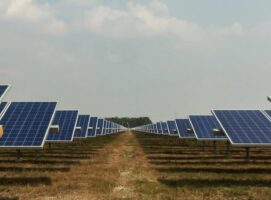Rice University researchers have flagged a possible major advance in the development of perovskite solar cells, regarded as the next big thing in solar PV that could lead to even more substantial cost reductions.
The cost of solar PV has plunged by 90 per cent over the last decade, helping to transform the nature of power grids and visions for the future. Perovskites have been hailed as the next big leap because they are light, and have a high tolerance for defects. But the they are also unstable.
The Rice University researches say they have a possible solution for perovskite solar cells’ persistent instability, which could help the technology make the leap from lab to market. And they say it comes from a new way of designing the cell itself.
In a paper published in Science, the researchers tested out a theory that a less efficient, but more stable, type of perovskite — a 2D form — could lend some of that toughness to more volatile perovskites in order to extend their lifespan and reduce chemical instability.
The team experimented with buttressing formamidinium lead iodide (FAPbI3), a material used to make perovskite cells which is excellent at absorbing light, to make it more structurally stable – and in the lab, it appears to be working.
“Perovskite crystals get broken in two ways: chemically ⎯ destroying the molecules that make up the crystal ⎯ and structurally ⎯ reordering the molecules to form a different crystal,” said Rice materials science student Isaac Metcalf, who was also a lead author on the resulting Science paper.
“Of the various crystals that we use in solar cells, the most chemically stable are also the least structurally stable and vice versa. FAPbI3 is on the structurally unstable end of that spectrum.”
Silicon-based solar cells have a maximum theoretical efficiency limit of 34 per cent. In practice, the highest efficiency ever measured was 26.81 per cent in 2022 by Chinese company Longi. The reality for most panels is maximum efficiency in the low 20s.
Perovskites have long been held up as one of the next possible steps in solar, because they are easier to make with significantly lower energy requirements and unlike silicon, have a high tolerance for defects. They’re light and can be put on a range of surfaces, opening the door to solar panels that can flex.
In recent years the efficiency of these cells has risen from just over 3 per cent to improve slightly on the maximum of silicon panels, which hovers just above 24 per cent.
However, they’re also extremely difficult to stabilise and currently have a lifespan of months, compared to decades that silicon panels can deliver. Scaling the technology will also be a challenge, as larger area cells are less efficient than smaller ones.
Building perovskites at scale has defeated many researchers and companies, including Dyesol in Australia, which turned into Greatcell Solar and then Greatcell Energy when its technology was rescued from liquidation in 2019.
Doping for muscle growth
The Rice team doped a FAPbI3 solution with specially designed two-dimensional (2D) perovskites; two had a surface structure similar to the lead iodide and two which were different.
The theory was that while the 2D material isn’t great at absorbing light, it is more chemically and structurally stable and might lend the 3D FAPbI3 some of that muscularity.
The idea worked, with the 2D perovskite providing a kind of template for the 3D perovskite to copy as it grew. The template added compression and stability to the 3D material’s crystal lattice structure.
“The addition of well-matched 2D crystals made it easier for FAPbI3 crystals to form, while poorly matched 2D crystals actually made it harder to form, validating our hypothesis,” Metcalf said.
“FAPbI3 films templated with 2D crystals were higher quality, showing less internal disorder and exhibiting a stronger response to illumination, which translated as higher efficiency.”
The scaffolding improved efficiency and durability.
Overall efficiency fell by less than 3 per cent over some 1,000 hours of operation at 85 degrees Celsius, while solar cells with the optimised 2D template didn’t start degrading even after 20 days. Adding an encapsulation layer improved durability to timescales that would make the system commercially viable.
Decades of work to get here, more needed
A report last year suggested that perovskite solar cells might be a “viable force” by 2030, a target based on 100 megawatts (MW) of commissioned pilot manufacturing lines at four key companies – Microquanta, GCL Perovskite, Utmolight, and Oxford PV.
But there is a long way to go to get the technology to that point.
In Australia, a pre-revenue startup in California called Caelux is looking hard at University of New South Wales research that simplifies how the performance of individual perovskite solar cells are tested. It’s an area that RMIT is also looking into.
Western Australian graphene supplier First Graphene, Halocell Energy, and Queensland University of Technology (QUT) won $2 million in funding from the Australian government last year to commercialise ultra low-cost and flexible perovskite solar cell fabrication techniques, using Halocell’s roll-to-roll (R2R) production process at its Wagga Wagga plant.
But researchers have been calling their results breakthroughs for a long time, and getting the technology off the ground will require a convergence of these ideas if that 2030 target could ever be realised.










